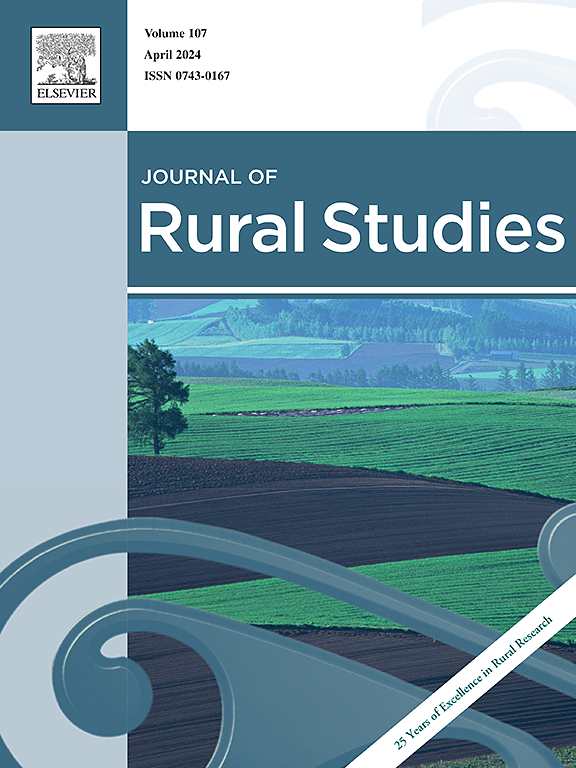各种各样的乡村梦想?中国乡村振兴中外部精英的乡村观念及其对乡村空间生产的影响
IF 5.7
1区 社会学
Q1 GEOGRAPHY
引用次数: 0
摘要
本研究关注的是,在中国乡村振兴的背景下,外部精英如何通过他们的乡村概念和相关实践来创造新的乡村空间。为此,我们在大水坡镇对外部精英、镇级官员和村参与者进行了有目的的抽样和深度访谈。大水坡镇是一个通过政府调解、大学平台和建立的精英网络引入精英的农村地区。本研究发展了Halfacree和Frisvoll关于乡村空间生产的概念,将关系、乡村振兴政策和士绅文化纳入中国语境。该研究确定了外部精英构想的六种乡村类型:实验场地、田园乡村生活、志同道合的社区、生产场地、可持续发展和乡村旅游。这些乡土性通过非物质(关系、乡村振兴政策)、物质(土地使用权、金钱)和个人实践(职业、家庭、生活方式追求)转化为新的乡村空间,士绅文化影响着非物质和个人实践。虽然这些实践创造了改善的基础设施、文化倡议和经济机会,但研究表明,缺乏社区能力建设,外部精英和当地社区之间缺乏社会空间隔离。研究结果表明,外部精英在大水坡的活动反映了一个独特的中国、国家嵌入的、以生产为导向的农村士绅化过程,在这个过程中,政府、锚定机构和精英密切合作,以实现各自的目标。该研究最后建议建立更有效的合作机制,让当地社区参与进来,建设它们的能力,从而促进更公平和可持续的农村发展。本文章由计算机程序翻译,如有差异,请以英文原文为准。
Varied rural dreams? External elites' conception of rurality and their influence on the production of rural space in China's rural revitalization
The study focuses on how external elites produce new rural spaces through their conceived rurality and related practices within the context of China's rural revitalization efforts in declining rural areas. For this purpose, purposive sampling and in-depth interviews were conducted amongst external elites, town-level officials, and village participants at Dashuipo Town, a rural area where elites are introduced through government mediations, university platforms, and established elite networks. The study develops Halfacree's and Frisvoll's conceptualization of the production of rural space by incorporating elements specific to the Chinese context: guanxi, rural revitalization policies, and gentry culture. The study identifies six types of rurality conceived by external elites: experimental site, idyllic rural life, like-minded community, production site, sustainable development, and rural tourism. These ruralities are translated into new rural spaces through immaterial (guanxi, rural revitalization policies), material (land use rights, money), and personal practices (career, family, lifestyle pursuits), with gentry culture impacting immaterial and personal practices. While these practices have created improved infrastructure, cultural initiatives, and economic opportunities, the study reveals the lack of community capacity building and social-spatial segregation between external elites and local communities. The findings suggest that the activities of external elites in Dashuipo reflect a uniquely Chinese, state-embedded, production-oriented rural gentrification process, where governments, anchor institutions, and elites work closely together to achieve their respective goals. The study concludes by recommending the development of more effective collaboration mechanisms to engage local communities and build their capacity, thus contributing to more equitable and sustainable rural development.
求助全文
通过发布文献求助,成功后即可免费获取论文全文。
去求助
来源期刊

Journal of Rural Studies
Multiple-
CiteScore
9.80
自引率
9.80%
发文量
286
期刊介绍:
The Journal of Rural Studies publishes research articles relating to such rural issues as society, demography, housing, employment, transport, services, land-use, recreation, agriculture and conservation. The focus is on those areas encompassing extensive land-use, with small-scale and diffuse settlement patterns and communities linked into the surrounding landscape and milieux. Particular emphasis will be given to aspects of planning policy and management. The journal is international and interdisciplinary in scope and content.
 求助内容:
求助内容: 应助结果提醒方式:
应助结果提醒方式:


